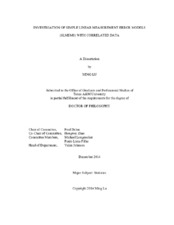| dc.description.abstract | The primary goal of this research is to develop statistical methods to determine if observed real responses are adequately modeled by (possibly stochastic) simulation models that incorporate first-order autoregressive measurement errors. We assume the measurement errors are normally distributed to allow development of likelihood-based methods of inference. Simulated true responses are modeled as a simple linear regression on the true response values. That is, we wish to detect if either additive or multiplicative biases exist in the simulation model. Efficient score and likelihood ratio tests using observed real process data are developed to test the joint null hypothesis that no significant additive or multiplicative biases exist in the stochastic simulation model. Tests for adequacy of both stochastic and deterministic simulation models are developed using, respectively, structural and functional simple linear measurement error models that allow the measurement errors to satisfy normal first-order autoregressive processes. A byproduct of this research is developments of analogous tests of the null hypothesis that errors of measurement are independent. Such tests would be of use if the real process is not a times series and there was uncertainty whether the simulation model should allow for correlated measurement errors.
Analytic and simulation results show that all maximum likelihood estimators (MLEs) of model parameters MLEs are consistent under the structural model, but some MLEs of parameters are inconsistent under functional model. Test statistics developed under the structural model are shown to be asymptotically distributed as chi-squared random variables with two degrees of freedom when testing for additive and multiplicative biases in the simulation model having correlated measurement errors. Test statistics developed under the structural model are shown to be asymptotically distributed as chi-squared random variables with one degree of freedom when testing for independence of the measurement errors. However, for functional models, the corresponding test statistics are asymptotically distributed as random variables that are two times the chi-squared distributions. Empirical power curves are plotted under different parameter configurations. Behaviors of test statistics and power curves are found to be affected by the sample size, signal to noise ratio and strength of correlations among measurement errors. | en |


